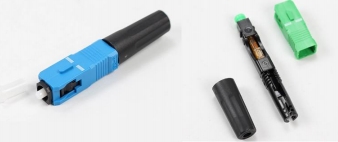Quick and Reliable Mechanical Connectors for Fiber Terminations: A How-To Guide

Introduction to Mechanical Connectors
Fiber termination has undergone a significant evolution, transitioning from traditional methods to the innovative approach offered by mechanical connectors. In the past, fiber terminations involved labor-intensive processes such as epoxy application and polishing. However, the introduction of mechanical connectors revolutionized this field by offering a more efficient and convenient solution for terminating fiber optic cables.
The decision to choose mechanical connectors over traditional methods is driven by their unparalleled attributes of speed, simplicity, and reliability. Unlike conventional techniques that require time-consuming steps like epoxy curing and polishing, mechanical connectors streamline the termination process, allowing for quicker deployment and reduced downtime. Their straightforward installation procedures make them an ideal choice for field installations where efficiency is paramount.
Understanding Mechanical Connectors for Fiber Terminations
Fiber optic networks rely on mechanical connectors to facilitate the seamless transmission of data. These connectors consist of several essential components that work together to ensure reliable fiber terminations. The primary parts include the ferrule, which holds the fiber in place with precision, and the housing, which protects the delicate fibers from environmental factors. Additionally, mechanical connectors feature a coupling mechanism that enables quick and secure connections between fibers.
The Benefits of Using Mechanical Connectors
The utilization of mechanical connectors presents a multitude of advantages for network installers and operators. Firstly, they offer time-saving solutions by eliminating the need for time-consuming epoxy curing and polishing processes. This streamlined approach significantly reduces installation time, allowing for quicker deployment of fiber optic connections. Moreover, their cost-effective nature makes them an attractive option for various applications, as they minimize labor costs associated with traditional termination methods.
Furthermore, mechanical connectors ensure consistency and quality in fiber terminations, leading to reliable network performance. Unlike manual polishing techniques that may result in inconsistent finishes, mechanical connectors provide uniform terminations across multiple connections. This standardization contributes to enhanced signal integrity and overall network reliability.
Step-by-Step Guide to Using Mechanical Connectors
Preparing the Fiber Optic Cable
Before installing a mechanical connector, it is crucial to properly prepare the fiber optic cable to ensure a reliable connection. This involves a series of essential steps, including stripping, cleaning, and cleaving.
Stripping
The first step in preparing the fiber optic cable is stripping the protective coating to expose the bare fiber. This process requires precision and care to avoid damaging the delicate fibers within. Specialized tools are used to carefully remove the outer layers, revealing the core fiber.
Cleaning
Once the fiber is exposed, thorough cleaning is necessary to remove any contaminants that could affect the quality of the connection. Cleaning solutions and lint-free wipes are employed to meticulously cleanse the exposed fiber, ensuring optimal performance during termination.
Cleaving
After cleaning, cleaving is performed to create a flat and perpendicular end face on the fiber. This process is critical for achieving precise connections with mechanical connectors. A cleaving tool is used to make a clean break, resulting in a smooth and uniform surface for optimal alignment within the connector.
Installing the Mechanical Connector
With the fiber optic cable properly prepared, it's time to proceed with installing the mechanical connector. This involves specific techniques for insertion and securement to establish a robust connection.
Insertion
Carefully aligning the prepared fiber with the connector's ferrule, gentle pressure is applied to ensure proper insertion into the connector housing. Precision is key during this step to prevent any misalignment or damage to the fibers, ultimately guaranteeing a reliable termination.
Securement Techniques
Upon insertion, various securement techniques are employed to firmly hold the fiber in place within the mechanical connector. These techniques may include crimping or snapping mechanisms designed to provide a secure and stable connection that withstands environmental stressors.
Testing for Reliable Fiber Terminations
After installation, it's imperative to conduct thorough testing procedures to validate reliable fiber terminations and ensure optimal performance throughout the network.
Ensuring Optimal Performance
Testing equipment such as optical power meters and visual fault locators are utilized to assess signal strength and identify any potential issues with connectivity or signal loss. These tests confirm that each termination meets stringent performance standards, guaranteeing consistent and dependable network operations.
Best Practices for Reliable Fiber Terminations
Regular Maintenance and Inspection
Sustaining reliable fiber terminations necessitates a proactive approach to maintenance and inspection. Regularly scheduled maintenance routines are essential for ensuring the longevity and performance of fiber optic connections. This involves conducting thorough visual inspections to detect any signs of wear, damage, or contamination. Additionally, periodic cleaning of connectors and adapters is imperative to prevent signal degradation and maintain optimal connectivity.
Implementing a structured maintenance plan not only safeguards the integrity of the network but also minimizes the risk of unexpected downtime due to connection issues. By adhering to a consistent inspection schedule, network operators can identify potential problems early on and take corrective measures promptly, thereby preserving the overall reliability of fiber terminations.
Keeping Your Connections in Top Shape
To uphold the dependability of fiber terminations, it's crucial to prioritize regular maintenance as a fundamental aspect of network management. By establishing a comprehensive maintenance regimen, organizations can uphold the performance standards of their fiber optic infrastructure while mitigating the likelihood of service disruptions.
Troubleshooting Common Issues
Even with meticulous maintenance practices in place, occasional issues may arise within fiber optic networks. Understanding common challenges and having effective troubleshooting strategies at hand is essential for maintaining reliable connections.
Tips for Quick Fixes and Avoiding Pitfalls
When encountering connectivity issues or signal degradation, swift action is paramount to minimize service disruptions. Equipping personnel with troubleshooting protocols and quick-fix techniques enables efficient resolution of common problems, safeguarding the continuity and reliability of fiber terminations.
See Also
Tips for Successful Termination of MPO Fiber Optic Connectors
Field Assembly of Fiber Optics: Exploring No Epoxy and Quick Connectors
3M SC/APC Blue Fast Connector: A Must-Have for Fiber Optic Applications
Fast Termination for Single Fiber: High-Quality 900um SC/UPC Connectors
Comprehensive Guide to APC Simplex 9/125um 3.0MM ST Fiber Optic Pigtail


